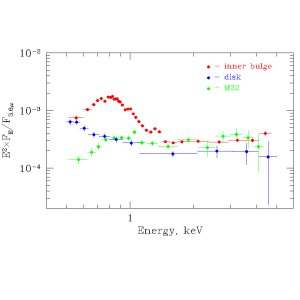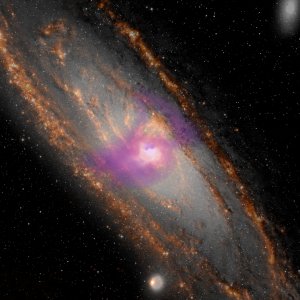 |
|
Fig. 1:
Soft X-ray image of the inner bulge (~1.5-2 kpc) of the Andromeda
galaxy obtained by Chandra X-ray Observatory. The majority of compact
sources are accreting neutron stars and stellar mass black holes in
binary systems. Unresolved X-ray emission is also clearly visible.
|
 |
 |
|
Fig. 2:
The brightness distribution of unresolved X-ray emission in
the 0.5 - 2 keV energy band along the major axis of the Andromeda
galaxy (compact sources removed).
The blue and red symbols show the Chandra and XMM-Newton data,
green histogram is the 3.6 micron near-infrared brightness
distribution from Spitzer. The grey area indicates the
amplitude of systematic uncertainties in the X-ray data related to
the imperfectness of the instrumental background subtraction.
The good overall agreement between X-ray and near-infrared light
distributions is apparent, as well as the presence of an excess in the
central ~10 arcmin.
|
 |
 |
|
Fig. 3:
X-ray spectra of the inner and outer bulge of the Andromeda galaxy and
of the nearby gas-poor dwarf elliptical M32. The excess emission in
the X-ray brightness distribution in Fig.2 reveals itself as a
prominent soft component in the inner bulge spectrum. The spectral
shape of the excess emission can be approximately described by the
emission of optically thin plasma of the temperature of 3-4
million K.
|
 |
|
Fig. 4:
Composite image of the Andromeda galaxy based on the multi-wavelength
data. The DSS optical image (grey) represents the distribution of the
stellar light, while the 24 micron data of Spitzer Space Telescope
(red) traces the distribution of cold gas and dust in spiral arms and
in the 10-kpc star-forming ring. Shown in purple is the soft X-ray
emission from warm ionized gas, the other components of X-ray emission
have been removed.
A striking feature of the morphology of the X-ray emitting gas
is that it is elongated along the minor axis, unlike everything else in
this galaxy. The gaps in the surface brightness of the gas emission
are caused by absorption by the cold material in spiral arms.
|
|  |
The X-ray radiation from the majority of galaxies is dominated by
bright compact sources (LX > 1036 erg/s) - accreting neutron stars
and black holes in binary stellar systems. In addition, unresolved
X-ray emission is present in galaxies of all morphological types.
It was revealed earlier by scientists at MPA that a part of this
emission is a superposition of a large number of much fainter,
LX ~ 1027-1034 erg/s, compact sources - accreting white dwarfs and
stars with active coronae
( Research Highlight January 2007, Research Highlight January 2007,
 Research Highlight March 2006).
For example, collective emission of
faint sources explains the most, if not all, of the X-ray
emission of the Ridge of our Galaxy. In many galaxies genuine diffuse
emission is also present which originates from the hot ionized
inter-stellar medium (ISM). The amount and importance of the X-ray
emitting gas varies from galaxy to galaxy, generally increasing with
its mass. Luminous gas-rich massive ellipticals and nearly gas-free
dwarf galaxies represent two opposite ends of the range. Research Highlight March 2006).
For example, collective emission of
faint sources explains the most, if not all, of the X-ray
emission of the Ridge of our Galaxy. In many galaxies genuine diffuse
emission is also present which originates from the hot ionized
inter-stellar medium (ISM). The amount and importance of the X-ray
emitting gas varies from galaxy to galaxy, generally increasing with
its mass. Luminous gas-rich massive ellipticals and nearly gas-free
dwarf galaxies represent two opposite ends of the range.
The Andromeda galaxy, our close-by neighbor, gives a unique
opportunity to explore a full-size spiral galaxy similar to our own
without complications brought about by projection effects and
absorption. Its 780 kpc distance and extensive coverage by the two
major X-ray observatories - Chandra and XMM-Newton and by the Spitzer
Space Telescope made it possible to disentangle different
components of X-ray emission and to study them in great detail.
The superb angular resolution of Chandra X-ray Observatory permitted
to locate and isolate contribution of accreting neutron stars and
black holes (Fig.1). After it had been removed, MPA scientists have
found a good overall agreement in the morphology and spatial
distribution of the remaining unresolved X-ray emission and stellar
mass measured through the 3.6 micron near-infrared
radiation (Fig.2). Remarkably, the X-ray-to-NIR luminosity ratios are consistent
with the Milky Way values. These findings suggest that the bulk of the
unresolved X-ray emission in the Andromeda galaxy has the same
origin as the Galactic Ridge emission and is produced by a large
number of faint compact sources of stellar nature.
This simple picture breaks down in the central ~10-15 arcmin
(~2-3 kpc) of the galaxy, where significant excess emission is present
in the soft band (Fig.2). The excess emission also reveals itself very
prominently as a strong soft component in the X-ray spectrum (Fig.3).
The morphology and spectral characteristics suggest that it is
associated with warm ionized ISM of the temperature of ~3-4 million K.
Interestingly, there is an evidence of non-solar abundance of metals
and/or non-equilibrium ionization state of the ISM.
The total gas mass is ~few million solar masses
with the typical density of ~0.01 particle per cm3. With these
parameters, the cooling time of the gas, tcool ~250 Myrs, is
significantly shorter than the life time of the galaxy. As such gas
is thermally unstable it can not be in a stationary
state in hydrostatic equilibrium in the gravitational potential of the
galaxy. On the other hand, the mass loss from evolved stars in the
bulge of Andromeda galaxy, ~0.1 Msun/year, is sufficient to double
the gas mass on the time scale of ~35 Myrs, much shorter that the
cooling time. This suggests that the gas outflows from the galaxy at
the rate, defined by the mass loss rate from the evolved stars,
i.e. ~0.1 solar masses per year. The outflow can be powered by
type Ia Supernovae which may provide upto ~ 1040 erg/s of
mechanical energy into the ISM. This is sufficient to heat the
gas and to lift it in the gravitational potential of the bulge.
A striking feature of the morphology of the X-ray emitting gas (Fig.4)
is that it is elongated along the minor axis, unlike everything else in
this galaxy. This suggests that the outflow proceeds predominantly
in the direction perpendicular to the disk of the galaxy.
The additional asymmetry of the X-ray brightness distribution, in
particular the gap seen to the north-west of the nucleus is caused by
absorption in spiral arms. The Andromeda galaxy has an inclination
angle of 77 degrees with the western side of the galactic
disk being closer to us. The ionized gas on this side of the
bulge is seen through the spiral arms, therefore the neutral gas and
dust in the star forming regions absorb soft X-rays casting a shadow
on the ISM emission. This does not happen on the eastern side of the
disk, which is located behind the bulge and does not obscure the gas
emission. The fact that the spiral arms and 10-kpc star-forming ring
do cast a shadow on the ionized gas places a lower limit on its
vertical off-plane extent, greater than 2.5 kpc.
Akos Bogdan and Marat Gilfanov
Publications
A.Bogdan & M.Gilfanov, 2008, MNRAS, 388, 56
 ADS ADS
|



